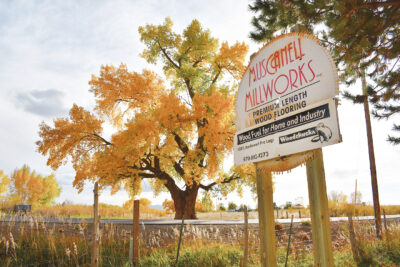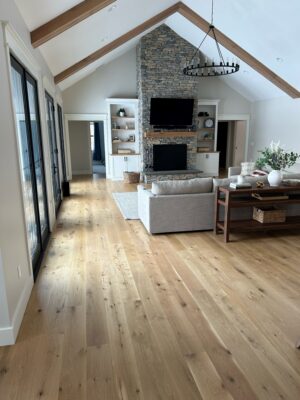Vietnam – According to the latest data available from the General Department of Customs Wood and Wood Products (W&WP) exports here were valued at US$1.2 billion in March of 2023, up 36 percent from February 2023, but down 23 percent compared to March 2022. WP exports stood at US$823 million, up 48 percent compared to February 2023 but down 30 percent compared to March 2022.
During the first three months of 2023, W&WP exports amounted to US$2.88 billion down 28 percent over the same period in 2022. WP exports contributed US$1.87 billion, down 39 percent over the same period in 2022.
Vietnam’s W&WP imports in March 2023 were valued at US$220 million, up 46 percent compared to February 2023, but down 7.6 percent compared to March 2022. For the first three months of 2023, W&WP imports were estimated at US$491 million, down 28 percent over the same period in 2022.
Imports of logs and sawnwood in March 2023 were 415,500 cubic meters, worth US$147.5 million, up 28 percent in volume and 27 percent in value compared to February 2023. However, compared to March 2022 imports did decrease by seven percent in volume and 12 percent in value.
During the first three months of 2023 imports of logs and sawnwood are estimated at 973,600 cubic meters, worth US$350.9 million, down 21 percent in volume and 25 percent in value over the same period in 2022.
Exports of Nontimber Forest Products (NTFP) in March of 2023 contributed US$70 million, up 24 percent compared to February 2023, down 22 percent compared to March 2022. NTFP exports generated, overall, in the first quarter of 2023, US$172.42 million, which is down 35 percent over the same period in 2022.
W&WP exports to the EU markets in March 2023 accounted for US$55.2 million, down 26 percent compared to the same period last year.
In March 2023 exports of kitchen furniture brought in about US$89.4 million, down 29 percent compared to March of last year. During the first quarter of 2023, kitchen furniture exports contributed US$216.7 million, down 30 percent over the same period in 2022.
European Union – The EU is closing in on new deforestation regulation. The legal process will introduce the new “EU Deforestation Regulation” (EUDR) and is nearing completion. In December of 2022 the European Council and the European Parliament agreed on the text of the regulation.
Once the law is implemented it will prohibit regulated commodities and derived products from being placed on the EU market unless they can be shown to be “deforestation free” and “forest degradation-free,” produced in accordance with applicable laws and covered by a “due diligence statement.” This will also prohibit their export from the EU under the same conditions.
The regulation will impose mandatory due diligence rules on companies to ensure that only compliant commodities and products enter the EU market or are exported from it.
The EU Timber Regulation (EUTR) will be repealed under the new regulation, which already imposes mandatory due diligence rules on EU timber traders.
Under the EUDR, annex 1 to the regulation contains a Combined Nomenclature (CN) list of products to be covered by the regulation. The scope of the regulation now includes “wood” alongside cattle, cocoa, oil palm, rubber and soya. In the original EC proposal rubber was not included.
The scope of wood products is similar but more extensive than for EUTR, including products in Chapter 44 (“wood”) of the EU CN; pulp and paper of CN Chapters 47 and 48, with the exception of bamboo-based and recovered (waster and scrape) products; printed papers in CN Chapter 49; and all furniture identified as composed wood, both seating and all other categories, in CN chapter 94. Key additions compared to EUTR are charcoal, all “other” wood products in Chapter 44, wooden seating and printed papers.
Within the EUDR’s definitions for “deforestation” and “forest degradation,” a deforestation commodity or product will have to be produced on land that has not been subject to deforestation after December 31, 2020, and for which wood has been harvested without causing “forest degradation” since that date. The prohibition on products from deforested or degraded forest land will apply irrespective of the legality of the harvesting operation.
“Deforestation” is defined in the regulation as the “conversion of forest to agriculture use, whether human induced or not.” The definition of forest is based upon the Food and Agriculture Organization (FAO) as “land spanning more than 0.5 hectares with trees higher than 5 meters and a canopy cover of more than 10 percent” while excluding “land that is predominantly under agricultural or urban land use.”
There is no protection for “other wooded land” in the agreed text, such as open savanna forest, although the preamble does state that an evaluation of the potential to extend the scope to other wooded land should be undertaken within a year after the entry into force of the regulation.
The legislation goes on to define forest degradation as “structural changes to forest cover, taking the form of the conversion of primary forests or naturally regenerated forests into plantation forests or into other wooded land and the conversion of primary forests into planted forests.”
According the EUDR a “primary forest” is a naturally regenerated forest of native tree species, without any human activities or ecological disturbances. This definition of “naturally regenerating forest” is very broad and is taken to mean, “Forests predominantly composed of trees established through natural regeneration. The definition also includes forests for which it is not possible to distinguish whether planted or naturally regenerated, as well as forests with a mix of naturally regenerated native tree species and planted or seeded trees, and where the naturally regenerated trees are expected to constitute a major part of the growing stock at stand maturity. The definition includes coppice from trees originally established through natural regeneration and naturally regenerated trees of introduced species.”
Indonesia – The European Union’s decision to impose new rules regulating the timber trade has pushed Indonesia to take action. The Ministry of Environment and Forestry (KLHK) finalized a “new” Timber Legality Verification System (SVLK). The SVLK has changed to the “Legality and Sustainability Verification System” with the same abbreviation, SVLK.
The new regulation will deal with the legality of timber sources and identifies the sources that are sustainably managed.
The Director General of Sustainable Forest Management in the KLHK, Agus Justianto, said a seminar held by the Indonesian Timber Panel Association (Apkindo), that the previous SVLK also had sustainability aspects in its criteria and indicators. According to Justianto, for the new SVLK, the word “sustainability” will now emphasize legality and sustainability.
Justianto said that the new SVLK has evolved to include a longer validity perod for certificates for cultivated wood. There are also financing facilities for certification for micro, small and medium enterprises.
Justianto went on to add that the government’s quick action in rebranding the SVLK should be appreciated as it deals with market requirements as the EU wood product market is large and that Indonesia must act quickly so that they can capture a greater market share. This will be a new paradigm for SVLK.
The Director for Processing and Marketing Forest Products at the KLHK said the SVLK was well accepted in the international market. He added that the SVLK has several attributes that make it acceptable, for example the SVLK has strict and well-maintained regulations to ensure the forest product legality and forest sustainability.
The SVLK continues to remain credible by carrying out verification through third parties, which are accredited by the National Accreditation Committee (KAN). SVLK is also strengthened by multi-stakeholder involvement in the development and implementation.
Implementation of the SVLK has been transparent as it relies on civil society to be independent monitors. Responding to the European Union’s plan to implement the Deforestation Free Supply Chain law (DFSC), the Director for Processing and Marketing Forest Products at the KLHK stated that Indonesia hopes that the European Union will continue to recognize the SVLK.
Indroyono Soesilo, the chairman of the Indonesian Forestry Community Communication Forum (FKMPI), stated that the SVLK is a credible system for Indonesia to satisfy the European Union’s DFSC regulations. This is due to SVLK increasing accountability and transparency which have an impact on improving forest governance in Indonesia.
China – There are efforts being made to develop markets for “green” home furnishings in rural areas to create new opportunities for manufacturers in the post pandemic era.
Since the end of the pandemic there has been an increase in awareness of health issues and the marketing of environmentally safe wood products across the country will add momentum to the trend.
According to a recent survey by the China Wood Production Industry Association (CWPIA) 50 percent of home decoration users are most concerned about formaldehyde, 30 percent are concerned about “energy saving and environmental protection” in the choice of home decoration, 20 percent choose “close to nature” as the theme style for home decoration. As a result of this survey, it is anticipated that the “green” household products will find a ready market.
The advantages of wooden frame buildings in the context of global energy conservation and emission reduction are gaining attention as wood frame buildings have a natural advantage, as carbon is fixed for a long period of time.
The Green Building Materials Certification Directory has included modern wood frame building materials. Throughout 2023 green building materials will be promoted to the countryside in five pilot regions. This promoting of green building materials will allow consumers to have a better understanding of the concept of green building materials.
The sales of green building materials have played a positive role in improving the productivity of building material product manufacturers by lifting the consumption of green building materials and improving the quality of rural housing construction, while promoting a good atmosphere for green consumption.
Experience suggests that it can take two years of practical experience to realize comprehensive promotion. The first that green building materials was sold in rural areas, was 2022. While some achievements have been made, supporting activities and implementation plans have not been implemented in pilot regions due to the impact of the epidemic. As the impact of the domestic epidemic dissipates this year, the campaign to send green building materials to the countryside is expected to expand.
Brazil – According to the latest data, Brazilian exports of wood-based products (except for pulp and paper) decreased by 19 percent in value compared to the same period last year, from US$423.2 million to US$341.9 million.
Pine sawnwood exports decreased 19 percent between March 2022 and March 2023 (US$60.1 million). In volume, exports decreased six percent over the same period, from 275,000 cubic meters to 258,900 cubic meters.
Tropical sawnwood exports fell 38 percent in volume, from 43,400 cubic meters in March 2022 to 27,000 cubic meters in March 2023. In value, exports decreased 18 percent from US$17.9 million to US$14.6 million over the same period. Pine plywood exports experienced a 22 percent decline in value in March 2023 compared to March 2022, from US$86.6 million to US$67.5 million.
In volume, exports dropped 0.4 percent over the same period, from 214,300 cubic meters to 213,500 cubic meters.
As for tropical plywood, exports decreased in volume by 45 percent and in value by 44 percent, from 6,200 cubic meters and US$3.2 million in March 2022 to 3,400 cubic meters and US$1.8 million in March 2023.
As for wooden furniture the export value fell from US$59.5 million in March 2022 to US$54.4 million in March 2023, an almost nine percent drop.









